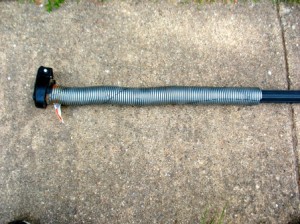Posted June 5th, 2010 at 2:20 pm by Dan Musick
About 20 years ago, galvanized garage door torsion springs broke into the garage door parts market as an alternative to oil-tempered springs. Later, electro-coating on oil-tempered torsion springs augmented the buyer’s set of choices.
Because traditional oil-tempered garage door torsion springs have an oily residue owing to their oil-enabled manufacture, installers often leave dirty smudges from the springs on the doors, to the ire of the customer. Many technicians install about 6-8 spring systems per day on a tight schedule and need to keep moving with repair work. As such, they find little time to wipe up, though some take the time. Galvanization came about to address this common and vexing issue.
Most in the garage door service industry, though, ably identify the problem with galvanized springs. Galvanizing weakens the spring. Anyone hammering a 16-penny galvanized nail knows metal weakening results from galvanization. And the results of galvanizing seem to prove no different with springs. Here is a shot of a galvanized spring from the Clopay EZ-Set system, now broken. Click to enlarge if necessary, and note the almost Fibonacci-style black line around the spring. Two curves in the line indicate a loss of two turns of tension at the point of breakage.
Spring Adjustments
Garage door owners, too, voice objections to galvanized springs because of high maintenance costs. Upon installation, one can count on an adjustment six months later, and then another at a similar interval. And so, the owner will need to “adjust” expectations when dealing with galvanized springs.
And so, a tough situation may arise. If a door loses significant tension from a galvanized spring installation, this may result in an insufficient lift to open the door. If you seek to remedy this by adding extra spring tension in a “hot” installation, you necessarily decrease the spring cycle life. However, if you do not add the initial tension, you get higher maintenance costs, especially when the cable may come off the drum, and a service call to rewind the spring and rectify the cable issue follows.
Galvanized versus Oil Tempered
About five years ago, an article with a galvanized vs. oil tempered motif appeared online. Although the author attempts to steer clear of taking a position in the debate, the assertions made may do little to sway those with direct field experience on the subject of garage door springs. Simply talk to an experienced technician for his or her perspective.
One proposed solution to the galvanized spring dilemma was the coated spring, thereby covering the oily residue. With these, a paint-like material coats the spring by means of special electrical bonding. Does this make the spring a lot cleaner? Maybe at the outset, but untimely decay of the finish has been observed on stocked items. Also, due to their initially clean appearance, coated springs do not often get oiled by installers. If a gap in the coating occurs, moisture may get into the dry crack in the spring, causing rust-and under tension–premature breakage.
And on the subject of lubrication, there is no case in which a newly-installed garage door spring should not be lubricated for protection against decay. Coated springs need to be lubricated, given the possible spottiness of coating coverage, and galvanized springs need oiling as well. DDM plans to show a video soon about the noisy results of not lubricating a galvanized spring. And yes, original oil-tempered springs could stand some additional rust-fighting lubricant once the springs are safely installed, of course, with a towel nearby.
Following is the our second post on garage door springs innovations – safety.
This entry was filed under History, How Garage Doors Work. You can follow any responses to this entry through the RSS 2.0 feed. You can skip to the end and leave a response. Pinging is currently not allowed.



Leave a Reply